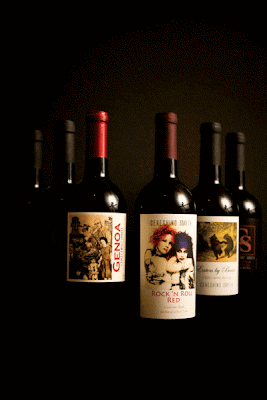From the Bowery to Bordeaux
I LOVE Fred & Paula and am dying to try their wine!

tish & snooky on the label!


Fred Smith and Paula Cereghino make wine in their renovated barn.
The wines of Cereghino-Smith
by Peter Barrett and photographs by Jennifer May, February 26, 2009
The essential point of collaboration—whether in marriage, art, music, or winemaking—is to create something that the individuals involved could not achieve separately. A few miles south of Kingston, in a funky old stone house, a collaboration that encompasses all four Cereghino-Smith strong suits is producing some high-quality wine in an improbable place.
Paula Cereghino is a visual artist who worked for years in the fashion and wine businesses, and Fred Smith is the bass player for the seminal New York punk band Television. Cereghino’s grandfather, who emigrated from Genoa, Italy, had a cooperative farm in Tacoma, Washington, where she grew up. “Every year they made about 200 gallons of wine—as much as they could [legally] get away with,” she explains. On a trip to Northern Italy about 10 years ago that centered on a visit with a first-rate winemaker, she became inspired to try it for herself. Smith developed his palate on tour: “Playing in a band that traveled to Europe often gave me lots of opportunities to try many wines,” he says. “I was lucky enough once to get a week off in Bordeaux while I was accompanied by a couple of English wine-enthusiast roadies. We rented a car and took off to Saint-Emilion, where we went on a shopping spree. After that I was able to get ‘two bottles of good Bordeaux’ put on the band’s backstage food rider.” Cereghino accompanied him on tour whenever possible, and they tasted together everywhere they went.
The duo began making wine in their apartment on Houston Street in 1999, shortly after Cereghino returned from Italy. They bought some California Zinfandel grapes and fermented the wine in 15-gallon glass demijohns. “‘I’ve got some homemade wine’ is one of the scariest things you can hear when visiting someone,” Smith says. “But it was just kind of fun to do. And when I had the first sip, at racking [siphoning the wine off the sediment], I couldn’t believe how good it tasted; it tasted like wine. Then the finished product was better than I had dreamed was possible.” Later, he bought Cereghino a small oak barrel for aging their wine as a gift. She remembers being relieved upon unwrapping it that it wasn’t “something dumb, like a computer.” Their enthusiasm quickly increased, and they began taking courses and seminars on winemaking—at the New York Horticultural Society, Cornell Cooperative Extension, and elsewhere. In 2003, they bought a 250-year-old house in Bloomington, renovated the accompanying barn, and began making wine at a professional level.
They buy their grapes from high-quality growers in California and hand-select and de-stem them before crushing. Fermentation takes place in three stainless tanks, and then the wine is aged in custom barrels, unique to this winery, with Canadian oak staves and American oak ends. This unusual combination allows the wines to benefit from the different qualities of the two woods; Canadian oak is considered to be a little closer to French oak in the subtler flavors it imparts to wine but costs substantially less. Smith’s recording studio is upstairs from the winemaking operation, and combines some seriously funky vintage processors with a computer and Protools, thus taking advantage of the best that old and new technologies have to offer. He clearly enjoys being an engineer as well as a musician, and this extends to the winemaking downstairs.
“He’s the scientist and I’m the artist,” Cereghino says as a shorthand way of explaining their complementary abilities. “We’re comfortable in our roles.” Smith explains that “what we make is dictated by what there is,” and describes the process of reconciling their passion for flavor with the technical process of achieving it as being similar to producing live-sounding music in the studio. As winemakers, they have their priorities carefully tuned; since most wine is bought to accompany a meal, all of their wines have refreshingly low alcohol—ranging between 12 and 14 percent—which makes them uncommonly nimble and food-friendly for wine made from California grapes these days. Paula explains that “we love food, so we try to make wine that goes well with food.”Their two most popular and inexpensive (around $20) wines are blends. Eaten By Bears is a blend of 42 percent Sangiovese, 37 percent Petite Sirah, and 21 percent Mourvedre. The name comes from a friend’s warning when he heard that they were moving to the country (“You’ll be eaten by bears!”) and the wine is bright and cheerful. Rock `n Roll Red is a blend of the same grapes, but in reverse proportion; Mourvedre dominates at 60 percent of the blend, with 25 percent Petite Sirah and 15 percent Sangiovese, making the wine sturdier and better suited to hearty fare. Genoa ($26), their newest blend of 75 percent Sangiovese and 25 percent Petite Sirah, features a pencil drawing by Cereghino on the label; taken from old family photos, she tinted it with espresso. Tasted from the barrel just prior to bottling, it revealed a more complex aromatic profile and depth of flavor than the other blends, which should easily justify its higher price.
They also make four single-varietal wines (in tiny quantities, from 150 to 180 hand-numbered bottles of each wine) and these represent the full expression of their passion for winemaking. The 2007 vintage is in bottle and available now. The Sangiovese ($26) is light in both color and flavor, with characteristic red fruit and a whiff of the nail polish smell that seems to haunt some California Sangiovese. The Mourvedre ($27) is darker and rounder, with more physicality and some of the feral fruit that makes this grape so special in Southern France. Most interesting right now is their Syrah (the label says “San Giuseppe,” a reference both to Paula’s Italian grandfather and to Saint-Joseph in France, one of the world’s best expressions of the Syrah grape). It showed well, drinking elegantly, and after a few days open on the kitchen counter continued to maintain ebullient fruit and structure—a sure sign of well made wine.
Their 2007 Petite Sirah ($45)—which they consider their flagship wine—has a lovely rich nose, but needs more time to unwind in the bottle before it’s ready to drink. This is a wine to lie down for three to five years and then open with a charred hunk of animal. The 2008 Petite Sirah is still in barrels: One is unadulterated, and the other has two percent Petit Verdot added as an experiment. Both versions are a deep, opaque purple—this grape is notoriously dark—and yet they have an astonishing and incongruous aroma of apricots and peaches that hovers above the inky fuchsia juice.
Still in barrel, the 2007 Little House ($40) is another blend that they consider to be their homage to Chateauneuf-du-Pape, the King of Southern Rhône wines in France. Named after their 18th-century house (built by the Huguenot immigrants, who brought wine grapes to New York), it includes Syrah, Mourvedre, and Petite Sirah. It looks to combine the best qualities of all three grapes, and they are clearly proud of it. Their house is pictured on the label, and they have high hopes that it will become a defining wine for them.
Their operation is not without hindrances, however; the barn is small, and so far they have room for only 14 barrels, though they may try to fit a couple more in soon. They now regret not rebuilding it completely, instead of renovating, but they were taken with the aesthetics of the barn’s old post-and-beam frame. The house is ancient, and beset with plumbing and other problems. Profitability is likely several years off, and the limits on volume will keep the margins tight for the foreseeable future. Their product is not really local, since the grapes are trucked 3,000 miles; though they are currently fermenting some Finger Lakes Cabernet Franc to see what it has to offer, they have resisted making Chardonnay or Riesling since they feel that there’s enough of those already being grown and made around here.
Yet these constraints also add to the appeal; this is very limited-edition boutique wine by two people with obvious talent and vision, and a very clear desire to emulate the Rhone wines they love best—but on their own terms. After only a few years in the business, they are making a distinct group of wines with unique character and indie cred. Word is spreading; Tim Sweeney of Stone Ridge Wine carries the blends and thinks “they’ve done a great job; good wine is not easy to make, and theirs are vibrant and elegant.” Rich Reeve, chef-owner of Elephant in Kingston, especially likes the Rock `n Roll Red with the tapas he serves. “Mourvedre is called Monastrell in Spain, and the wine is similar in flavor points to a good Spanish red,” he says.
With total production of a few hundred cases—a small fraction of even an average boutique winery—Cereghino-Smith is giving our area a taste of DIY wine with a sterling punk pedigree.
For a list of the local restaurants and retailers who carry Cereghino-Smith wines, visit www.cereghinosmith.com.


0 Comments:
Post a Comment
Subscribe to Post Comments [Atom]
<< Home